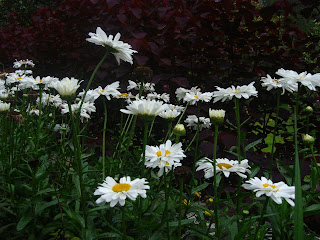 Stalls selling RTW, miscellaneous export overruns, and shoes from Marikina. Big tents set up by telecom and cigarette companies and those nifty gift items they give away and amusing promotional gimmicks they come up with to grab the attention of passers-by. Rows and rows of food stalls selling shawarma, sweet corn-on-the-cob, and barbecue.Free rock concerts that hopefully won’t result in brawls between intoxicated under-aged members of rival gangs.
Stalls selling RTW, miscellaneous export overruns, and shoes from Marikina. Big tents set up by telecom and cigarette companies and those nifty gift items they give away and amusing promotional gimmicks they come up with to grab the attention of passers-by. Rows and rows of food stalls selling shawarma, sweet corn-on-the-cob, and barbecue.Free rock concerts that hopefully won’t result in brawls between intoxicated under-aged members of rival gangs.Sure, there’s the occasional stall actually selling plants and flowers, usually outnumbered by stalls selling plastic flowers and other fake plants.
Because of the way it has evolved through the years, these are the things that usually come to mind when you mention Panagbenga, or the Baguio Flower Festival. Sadly, it has ceased to be a celebration of Baguio’s natural beauty and has become a mere month-long tiangge. It seems like the only thing that somehow still relates to anything floral are the parades, and even those now showcase fake flowers made of plastic and crepe paper.

Add to that the sight of politicians, since according to the guidelines issued by the organizers, political parties will actually be allowed to participate in the float parade as long as they “don’t shake the hands of spectators so as not to disrupt the flow of the parade.” Great.

If this trend continues, then we might as well stop calling it the Bagiuo Flower Festival and call it simply, the Baguio Festival, or maybe The-Festival-That-Just-Happens-to-be-Held-in-Baguio.
A century and a half ago, when the Spaniards finally succeeded in conquering this part of the Cordilleras with the intention of getting their hands on the area’s riches, particularly gold, they were stunned by Benguet’s sheer beauty: its magnificent skyline, its healthful climate, the presence of plants, flowers and vegetables that do not grow elsewhere in the country, all of these made the colonizers turn their attention to the creation of a health resort, or a hill station in what was then known as Kafagway.
 So you would think that a festival called Panagbenga would be a celebration of that distinct natural beauty that captivated our colonizers more than a hundred years ago - those sunflowers that begin to blanket the mountainsides in November, the roses that grow so succulently all year round, the marigolds, snapdragons, carnations, daisies, lilies that can be found all over Baguio.
So you would think that a festival called Panagbenga would be a celebration of that distinct natural beauty that captivated our colonizers more than a hundred years ago - those sunflowers that begin to blanket the mountainsides in November, the roses that grow so succulently all year round, the marigolds, snapdragons, carnations, daisies, lilies that can be found all over Baguio. Or maybe at least call attention to the simply beautiful but sadly slowly vanishing Benguet Lily, endemic to this part of the country, which dies when taken out of its natural environment (very much like the city itself).
Not so long ago, we took a walk around the city’s downtown area to take photos of whatever flowers we may find along the way, and were amazed by the number of different species, as shown in the photos, that can be found just within Baguio’s Central Business District.
Yup, they’re there, taken for granted, mostly unnoticed.
Which makes one think, why do they keep on coming up with “new, innovative ideas” that are supposed to make the festival better, when Panagbenga’s, or the Baguio Flower Festival’s supposed raison d’etre can be found all over the place? Stop and smell the roses that are right under your noses.
you make a very poignant point.
ReplyDeleteon a tangent, it was on a trip to Baguio of the UP Diliman ROTC Corps that dad won mom's heart and he called her his "Benguet Lily". dad was UP's Corps Commander and they were there to visit the PMA. the city must have been enchanted in the early '50s. i believe it can still be that if the people of Baguio decide and commit to re-creation.